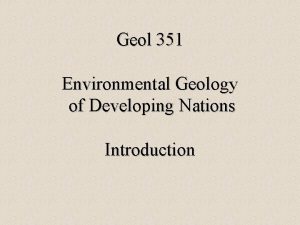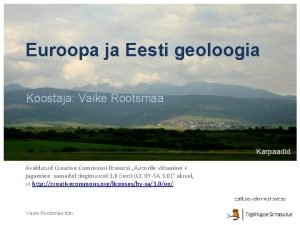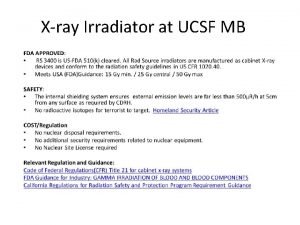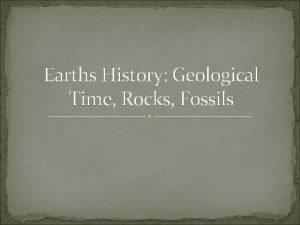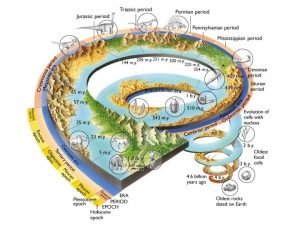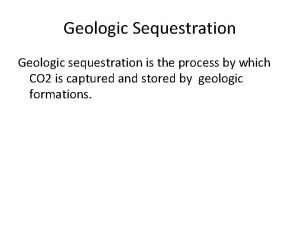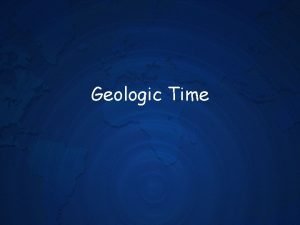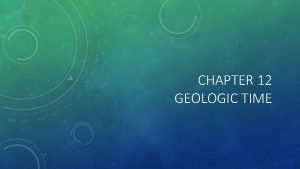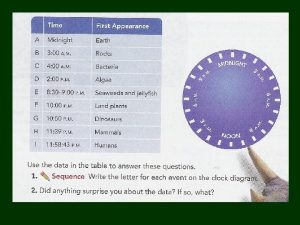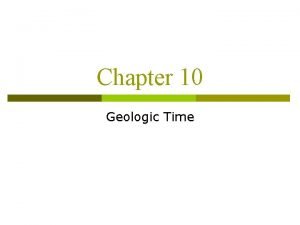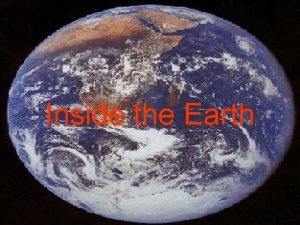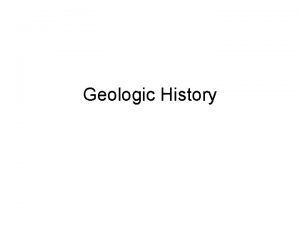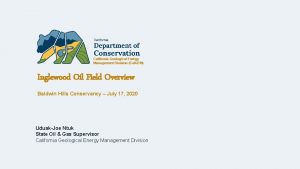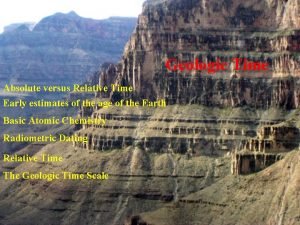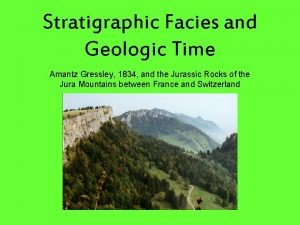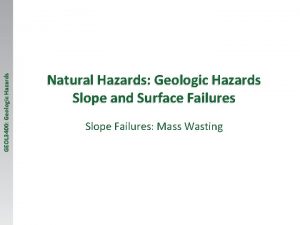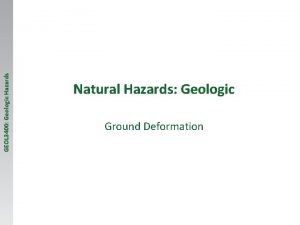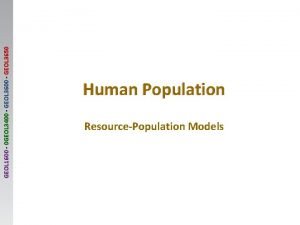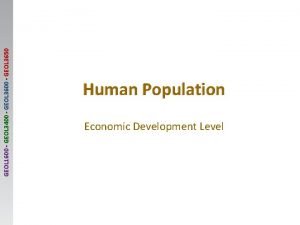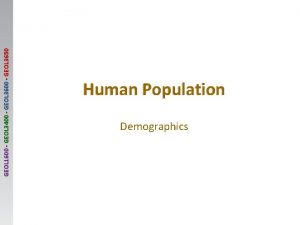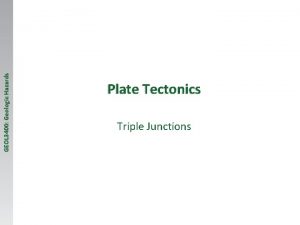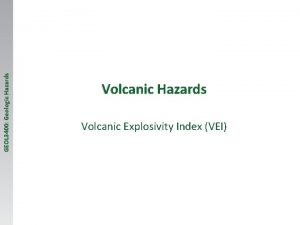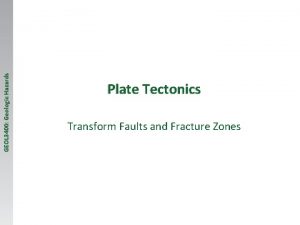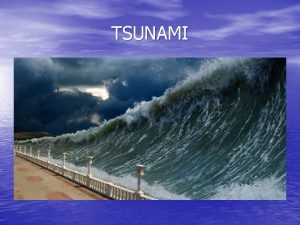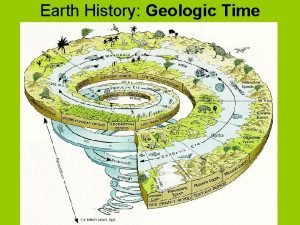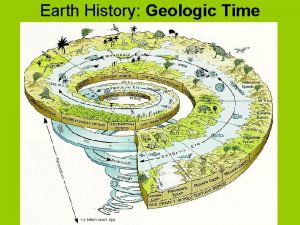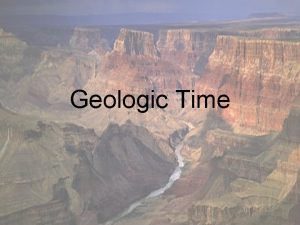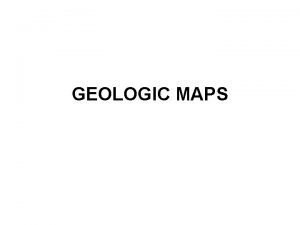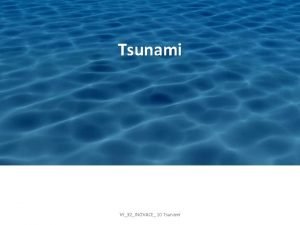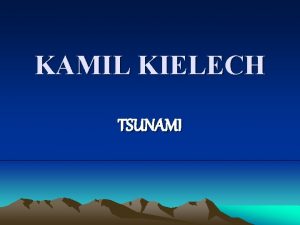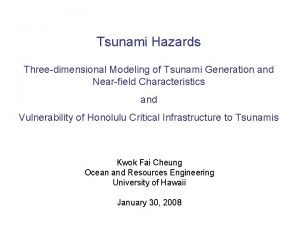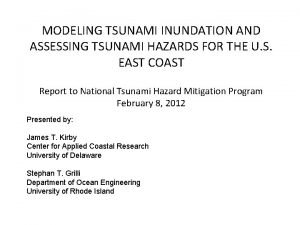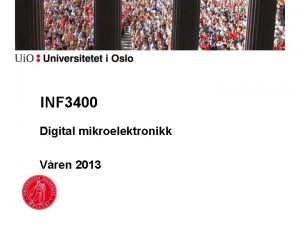GEOL 3400 Geologic Hazards Tsunami Mechanics http resource



























- Slides: 27

GEOL 3400: Geologic Hazards Tsunami Mechanics http: //resource. isvr. soton. ac. uk/spcg/tutorial/Tutorial_files/Web-basics-frequency. htm 31 -Aug-21 1

Tsunami: Mechanics GEOL 3400: Geologic Hazards Introduction • a tsunami are giant, long-period sea waves caused by oceanic disturbances – produced by sudden displacement of a large volume of water • tsunami are, in fact, wave systems that spread out from a point of energy release – the number of waves produced vary • commonly the 3 rd through 8 th wave are the largest – have periods of 10 -20 minutes or longer – when they arrive at a distance shore, these waves may be separated by tens of minutes to hours • a seiche is a slow, rhythmic oscillation of water in enclosed or nearly enclosed bodies of water – results from seismic action or storm conditions – water sloshes back and forth with waves usually no more than 5 feet 31 -Aug-21 2

Tsunami: Mechanics GEOL 3400: Geologic Hazards Wave Characteristics • Tsunamis behave very differently from typical wind-produced ocean waves. Because of this, the mechanics of tsunamis are different and detecting them is difficult. 31 -Aug-21 3

Tsunami: Mechanics Wave Characteristics GEOL 3400: Geologic Hazards • a wave is basically an energy carrier 31 -Aug-21 – thus, tsunami is carrying energy away from where it has been suddenly released by some geologic process • understanding tsunami hazards requires knowing about the characteristic of waves • primary wave features that are independent of time are: 4

Tsunami: Mechanics Wave Characteristics GEOL 3400: Geologic Hazards • terminology used to describe tsunamis are same as that for any wave – seismic, water, sound, etc. • the physical form of a wave is characterized by the following parameters: – wavelength: distance from one point on the waveform to the adjacent identical point, e. g. trough to trough, or crest to crest – amplitude: height from still water line to wave crest or from same line to wave trough – wave height: distance from trough to crest, equal to twice the amplitude – trough: lowest point of wave – crest: highest point of wave • the terminology used to describe a tsunami is the same as that used for all other waves, e. g. sound, light, ocean wave, etc. 31 -Aug-21 5

Tsunami: Mechanics Wave Characteristics GEOL 3400: Geologic Hazards • is a longitudinal wave of compressional nature 31 -Aug-21 6

Tsunami: Mechanics Wave Characteristics: Wavelength GEOL 3400: Geologic Hazards • wavelength (L) of a tsunami can be greater than 200 km – nearly 200 times normal ocean wave with a wavelength of about 100 m – the depth to which a wave affects the water column is related to its wavelength, i. e. L/2 • with wavelengths of hundreds of kilometers, a tsunami affects the entire water column • thus, tsunami “feel” the ocean bottom even in the deepest part of the ocean basin – consequently, tsunami are ‘shallow-water’ waves • because energy loss is inversely proportional to wavelength, not much energy is dissipated as the tsunami crosses even a large ocean basin 31 -Aug-21 7

Tsunami: Mechanics GEOL 3400: Geologic Hazards Wave Characteristics: Wavelength • shallow vs deepwater waves • tsunami/diagrams/wave. gif 31 -Aug-21 8

Tsunami: Mechanics GEOL 3400: Geologic Hazards Wave Characteristics: Wavelength 31 -Aug-21 9

Tsunami: Mechanics GEOL 3400: Geologic Hazards Wave Characteristics: Wavelength Robke & Vott (2017) 31 -Aug-21 10

Tsunami: Mechanics GEOL 3400: Geologic Hazards Wave Characteristics: Wavebase • One important way in which tsunamis differ from wind-generated waves is their wavelength • The wavelength of a tsunami is hundreds of kilometers compared to wavelengths measured in meters for wind-produced waves • Since wavebase, the depth at which water is disturbed by the passage of the wave, is related to wavelength, tsunami and wind waves behave very differently • Wavelength (L) and wavebase are related by relation: 31 -Aug-21 11

Tsunami: Mechanics Wave Characteristics: Amplitude GEOL 3400: Geologic Hazards • at sea, the amplitude of a tsunami is on the order of a meter or less – noticeable in other ocean waves – thus, tsunami are not hazards to ships at sea • as the wave approaches shallow water, its height builds and its energy is concentrated into a smaller region – because the depth decreases, the wave slows and its height increases – wavelength decreases thereby piling waves on top of each other – bottom of the wave is slowed by the seafloor, but the crest is not • top gets ahead of the base and finally crashes forward or breaks 31 -Aug-21 12

Tsunami: Mechanics GEOL 3400: Geologic Hazards Wave Characteristics: Amplitude Robke & Vott (2017) 31 -Aug-21 13

Tsunami: Mechanics Wave Characteristics: Amplitude GEOL 3400: Geologic Hazards • normally most damage is done from tsunami generated locally – of 104 damaging tsunami in the past century, only 9 have produced damage outside their local areas • the maximum amplitude of a tsunami is related to magnitude of earthquake and its focus depth as well as the water depth above the epicenter • with distance from source, amplitude decreases (but slowly), but the number of waves increases 31 -Aug-21 14

Tsunami: Mechanics GEOL 3400: Geologic Hazards Tsunami Characteristics: Drawdown • drawdown is the sudden lowering of water level before a tsunami strikes – because wavelength so great, the path followed by water particles is long • draws water out toward wave – has proven deadly to onlookers – first indication of a tsunami need not be a drawdown • often arrives as a series of crest – largest need not be the first – it can take successive crests up to an hour to reach shore – because frequency (time between crests) varies with velocity and wavelength 31 -Aug-21 15

Tsunami: Mechanics GEOL 3400: Geologic Hazards Wave Characteristics – Time Dependent • a wave’s is not fixed in time, that is the wave propagates in the direction of wave motion • terms that describe the change in a wave with time: – wave period (p) is the length of time required for a wavelength to pass a fixed point • that is the time between adjacent crests, troughs or any equivalent point on the wave form • the faster a wave is moving, the shorter the period • measured in seconds (f): number of waves that pass a point in one second – frequency (f) • measured in Hertz (Hz), i. e. inverse seconds – relation between period and frequency is: 31 -Aug-21 16

Tsunami: Mechanics GEOL 3400: Geologic Hazards Wave Characteristics - Time 31 -Aug-21 17

Tsunami: Mechanics Tsunami Characteristics: Run-up GEOL 3400: Geologic Hazards • factors influencing run-up include: • water depth • sea floor profile and topography • coastline shape, e. g. bay configuration • along steep coasts, the waves do not slow and break but grow rapidly as approaches shore • allows a very large run-up 31 -Aug-21 18

Tsunami: Mechanics Period GEOL 3400: Geologic Hazards • the period of a tsunami is related to earthquake magnitude by: where T = period, and M = Richter magnitude – scales for defining the magnitude of a tsunami are based on logarithm of maximum wave amplitude observed locally • similar to Richter scale • Imamura-Iida scale is calculated as a function of maximum wave height along coast – different magnitudes for same tsunami at different places along coast 31 -Aug-21 19

Tsunami: Mechanics GEOL 3400: Geologic Hazards Wave Characteristics - Frequency 31 -Aug-21 20

Tsunami: Mechanics GEOL 3400: Geologic Hazards Wave Characteristics - Frequency 31 -Aug-21 21

Tsunami: Mechanics Tsunami Characteristics: Run-up GEOL 3400: Geologic Hazards • run-up is the elevation a tsunami reaches above sea level – measured in meters (or feet) 31 -Aug-21 22

Tsunami: Mechanics GEOL 3400: Geologic Hazards Wave Characteristics - Time 31 -Aug-21 23

Tsunami: Mechanics Velocity GEOL 3400: Geologic Hazards • the velocity of a tsunami is related to ocean depth by: where g is the acceleration due to gravity (9. 81 m/s 2 [32. 19 ft/s 2]) and D is water depth, i. e. depth of the ocean – for depth of 4, 000 m, the tsunami velocity would be 198 m/s (649 ft/s) or 713 km/hr (443 mi/hr) • for the average Pacific Ocean depth of 5, 500 m (18, 040 ft), tsunami velocity is 232 m/s (761 ft/s) or 834 km/hr (518 mi/hr) – because tsunami always feels the bottom, they are effectively slowed to 675 -722 km/hr (420 -480 mi/hr) • takes less than 24 hours to cross Pacific Ocean – as tsunamis approach shore, they are slowed down by the shallowing seafloor • can still be moving 50 -80 km/hr (30 -50 mi/hr) • much too fast for human to outrun 31 -Aug-21 24

Tsunami: Mechanics GEOL 3400: Geologic Hazards Velocity • For any type of water wave, the wave's wavelength (L), velocity (c) and period (T) are related by the following relations: 31 -Aug-21 25

Tsunami: Mechanics GEOL 3400: Geologic Hazards Energy • the energy transported by tsunami is distributed from the ocean floor to the ocean surface • tsunami contain enough energy to destroy most man-made structures – in the Krakatau tsunami (1883), the steamer Berouw was carried 2. 5 km inland deposited 24 m above sea level 31 -Aug-21 26

Tsunami: Mechanics GEOL 3400: Geologic Hazards Summary 31 -Aug-21 27
 Compare geologic time with the geologic column.
Compare geologic time with the geologic column. Geology 351
Geology 351 Settelünk
Settelünk Unlimited number of significant figures
Unlimited number of significant figures Rs 3400 blood irradiator price
Rs 3400 blood irradiator price Cis 3400
Cis 3400 Rs 3400 blood irradiator
Rs 3400 blood irradiator 453 eksiği 169 olan sayı kaçtır
453 eksiği 169 olan sayı kaçtır Dhhs form 3401
Dhhs form 3401 Disclosure deficiency
Disclosure deficiency Resource loading vs resource leveling
Resource loading vs resource leveling Perbedaan resource loading dan resource levelling
Perbedaan resource loading dan resource levelling Geologic time
Geologic time Brainpop geologic time
Brainpop geologic time Geologic time scale poem
Geologic time scale poem Geologic history
Geologic history 4 divisions of geologic time
4 divisions of geologic time Geologic sequestration
Geologic sequestration How is the geologic time scale organized
How is the geologic time scale organized Chapter 12 geologic time
Chapter 12 geologic time Time scale
Time scale The longest subdivision of the geologic time scale is the
The longest subdivision of the geologic time scale is the Geologic layers of earth
Geologic layers of earth Geologic time scale drawing
Geologic time scale drawing Geologic history
Geologic history California department of conservation
California department of conservation Geologic
Geologic Facies
Facies

